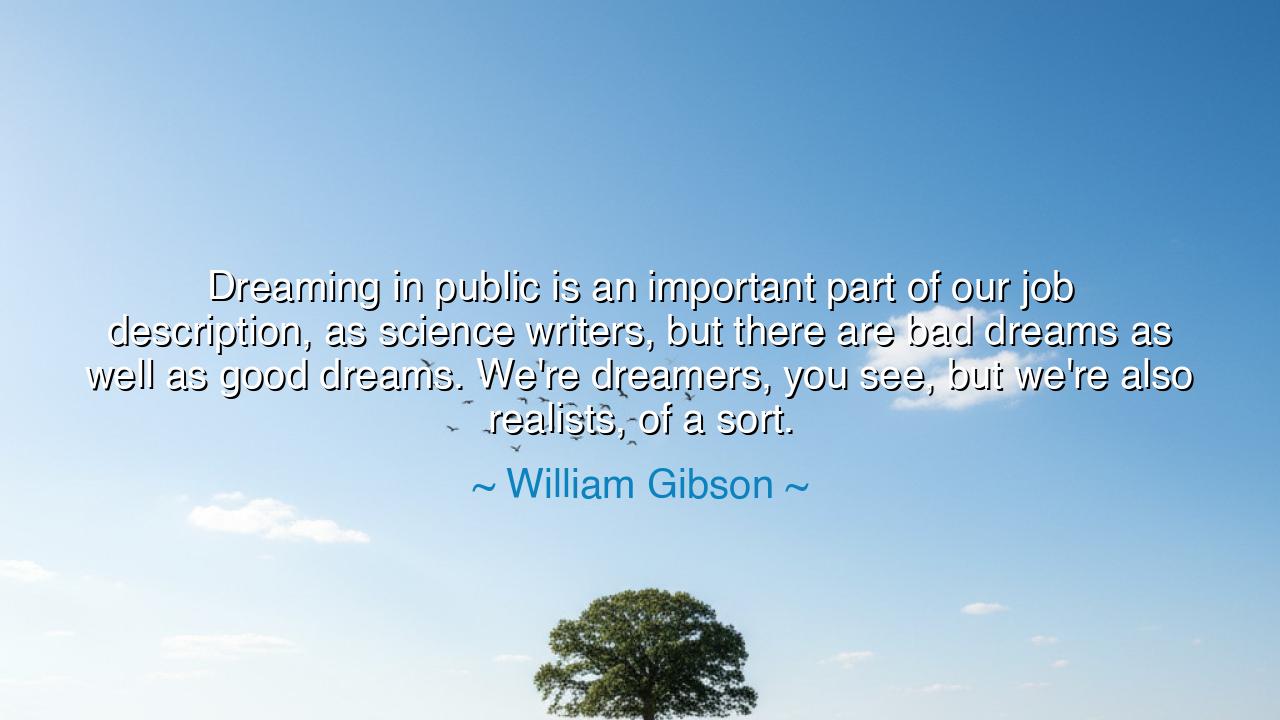
Dreaming in public is an important part of our job description
Dreaming in public is an important part of our job description, as science writers, but there are bad dreams as well as good dreams. We're dreamers, you see, but we're also realists, of a sort.






“Dreaming in public is an important part of our job description, as science writers, but there are bad dreams as well as good dreams. We're dreamers, you see, but we're also realists, of a sort.” – William Gibson
When William Gibson, the visionary father of cyberpunk, spoke these words, he was not merely speaking of fiction — he was speaking of the burden of vision itself. For to dream as a writer of science and imagination is not to escape from the world, but to foresee its future, to stand at the crossroads of what is and what might be. He calls this act “dreaming in public,” because the writer dares to reveal, before the eyes of all, the secret tides of human destiny — the wonders we may create, and the perils we may unleash. Yet Gibson, ever the prophet of both brilliance and decay, reminds us that there are bad dreams as well as good dreams. The same imagination that gives birth to progress can also summon nightmares, for creation and destruction are twins born of the same spark.
The origin of this quote lies in Gibson’s reflections on the power and responsibility of speculative writing. Long before the internet shaped our world, Gibson dreamed of a realm of digital connection he called “cyberspace” — a term he himself coined. His vision, first laid out in his 1984 novel Neuromancer, was a tapestry of machines and minds entwined, where humanity reached beyond its limits but also lost pieces of its soul. It was both prophecy and warning. And in these words, he confesses the truth behind such foresight: that to imagine the future is to wrestle with its demons. The science writer, he says, must dream — but dream honestly, acknowledging the beauty of invention and the shadow that walks beside it.
In every age, humanity has walked this narrow bridge between dream and reality. The inventors of the past — men like Leonardo da Vinci, who sketched flying machines centuries before they could exist — were dreamers too. Yet Leonardo also feared the destructive uses of his ideas. He wrote in secret codes, hiding his knowledge of weapons lest it fall into the wrong hands. Like Gibson, he understood that imagination is a fire, capable of warming the world or burning it. The dreamer’s gift is divine, but his duty is grave: to shape vision with conscience, to temper creation with wisdom.
Gibson’s phrase “bad dreams as well as good dreams” speaks to this duality. Every great technological dawn casts a long shadow. The nuclear age brought both the light of energy and the darkness of annihilation. The internet promised global connection but also birthed division, manipulation, and the erosion of truth. The dreamers who foresaw these things were not naïve; they were realists of a sort, as Gibson calls himself — those who love the future enough to warn it. For the true visionary does not simply glorify what could be; he questions what should be. He sees the splendor of possibility and the peril of human pride intertwined, like roots of the same tree.
In this, Gibson’s words also reveal the paradox of the science writer’s soul. To write of what might come is to live between two worlds: one foot planted in the soil of fact, the other stepping into the mist of imagination. The writer must believe in progress, yet doubt it; must dream of machines that heal, yet know they may enslave. This balance — this sacred tension between hope and caution — is what Gibson calls being both a dreamer and a realist. He reminds us that the future is not an inevitable unfolding, but a choice humanity makes every day through its inventions, its desires, and its ethics.
Let us then look to history for another lesson — the story of Mary Shelley, who, long before the age of computers, wrote Frankenstein. In that dark and brilliant tale, she too dreamed in public. She imagined the triumph of science over death — and the terror of its misuse. Her story was not merely fiction; it was prophecy. It told of the arrogance that drives man to create without compassion, to play god without wisdom. In her “bad dream,” as in Gibson’s, we see reflected the eternal truth: that imagination without conscience becomes a monster, and progress without humility leads to ruin.
So, my friends, take this wisdom into your own hearts. Dream, yes — but dream responsibly. Let your imagination wander boldly, but let your conscience hold its reins. When you envision the future, do not seek only what dazzles, but also what endures. Ask not just “What can we create?” but “What kind of world will this creation serve?” For to dream in public is to accept a sacred duty — to be a guardian of tomorrow’s soul. The realist dreamer, as Gibson teaches, is not one who fears the future, but one who shapes it with care.
And thus, let it be remembered: the world will always need its dreamers — but the dreamers it needs most are those who can look into the abyss of their own creation and still choose the light.






AAdministratorAdministrator
Welcome, honored guests. Please leave a comment, we will respond soon